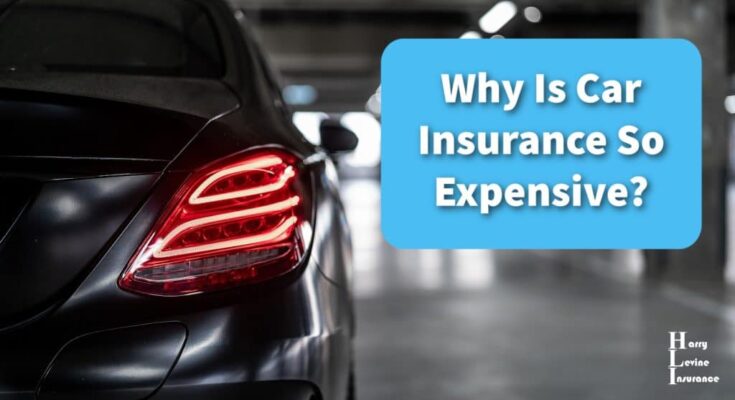Introduction
Why Is Car Insurance So Expensive, In this day and age, car insurance is fundamental. It gives true serenity, monetary security, and consistence with the law. In any case, numerous drivers are left pondering, Why is vehicle insurance so expensive? In this article, we will dig into the different variables that add to high vehicle protection costs, examining how your driving record, vehicle type, area, and other basic components impact the payments you pay. With an unmistakable comprehension of these elements, you can pursue informed choices and possibly track down ways of lessening your protection costs.
1. Figuring out the Rudiments: What is Vehicle Protection Premium?
A car protection premium is the sum policyholders pay occasionally to keep up with their protection inclusion. Insurance agency decide these expenses by evaluating a scope of hazard factors that foresee the probability of a mishap or guarantee. The higher the gamble, the more you are probably going to pay. By understanding the parts of vehicle protection and what impacts its value, drivers can acquire knowledge into the explanations for the occasionally amazing expenses. Why Is Car Insurance So Expensive.
2. The Job of Driving Record and Claims History
Perhaps of the main element that insurance agency consider is your driving record. Drivers with a background marked by mishaps, petty criminal offenses, or cases are seen as higher-risk clients. Subsequently, they are frequently expected to pay higher charges. Here’s the reason:
- Mishaps and Traffic Violations: Past mishaps and criminal traffic offenses signal a higher likelihood of future cases, making drivers more exorbitant to safeguard. Back up plans change expenses appropriately, with serious offenses like DUIs or careless driving conveying the steepest increments.
- Claims History: Regardless of whether you weren’t to blame in a mishap, a background marked by cases can raise your charges. Protection suppliers frequently decipher a continuous cases history as a pointer that you drive in higher-risk circumstances or regions.
3. Vehicle Type and Model
The type and model of your vehicle assume a basic part in deciding protection costs. Insurance agency evaluate factors, for example,
- Vehicle Value: Very good quality or extravagance vehicles are more costly to fix or supplant, expanding likely expenses for back up plans. Accordingly, they draw in higher charges.
- Wellbeing Evaluations and Features: Vehicles outfitted with cutting edge security highlights, for example, airbags, electronically monitored slowing mechanisms, and crash discovery frameworks, can lessen the gamble of wounds in mishaps. Back up plans might offer limits on more secure vehicles, while superior execution or sports vehicles commonly cost more to safeguard because of the expanded mishap risk.
- Burglary Rates: A few vehicles are more famous among hoodlums, prompting a higher probability of robbery claims. For instance, sports vehicles and certain SUV models are normally designated, raising the protection rates for those particular vehicles. Why Is Car Insurance So Expensive.
4. Area and Protection Premiums
Where you live fundamentally influences your vehicle protection rate. Area based risk factors include:
- Populace Density: Metropolitan regions with higher traffic thickness will generally have more mishaps and higher cases rates, prompting raised protection costs.
- Burglary and Defacement Rates: Living in a space with high paces of vehicle robbery or defacing expands the possibilities documenting a case, subsequently raising expenses.
- State Regulations: Each state in the U.S. has special protection necessities, and least inclusion levels change. A few states require more significant levels of inclusion, expanding benchmark expenses.
5. Age and Gender
Insights show that more youthful drivers, especially youngsters, have a higher mishap rate than more seasoned drivers. Thusly, teen and youthful grown-up drivers pay the absolute most noteworthy insurance installments. Moreover, orientation assumes a part in protection computations:
- More youthful Drivers: Drivers under 25, particularly guys, are viewed as high-risk because of freshness and measurably higher mishap rates.
- Moderately aged Drivers: Charges normally decline as drivers arrive at their 30s and 40s since they are seen as more secure, more experienced drivers.
- Senior Drivers: As drivers age, charges might rise again because of expected decreases in vision, response time, and mental capacities.
6. Yearly Mileage and Usage
The number of miles driven each year influences your vehicle insurance installments. The more you drive, the more prominent the probability of a mishap. Safety net providers consider both mileage and use type:
- Driving and Business Use: Vehicles utilized for business or incessant significant distance driving are at more serious gamble because of expanded time out and about. Thus, charges for such vehicles are higher than those utilized exclusively for individual or sporting purposes.
- Low-Mileage Discounts: Numerous guarantors offer limits for policyholders who drive under a specific yearly mileage. These limits recognize the diminished mishap risk for drivers who invest less energy out and about.
7. FICO assessment and Protection Rates
In many states, credit scores are figured into vehicle protection rates. Guarantors frequently view a lower FICO rating as a sign of a higher probability of recording claims. Albeit disputable, this training is predominant and can affect your premium:
- Great Credit: Drivers with solid FICO ratings will generally get lower expenses as they are measurably more averse to record claims.
- Poor Credit: A low FICO rating can essentially expand your protection rate. Safety net providers contend that drivers with lower FICO ratings present a higher gamble, prompting expanded charges.
8. Protection Inclusion Choices and Deductibles
The coverage options you pick and the deductible sum additionally influence your premium. This is how it’s done:
- Sorts of Coverage: Full inclusion, which incorporates obligation, impact, and extensive protection, costs more than least risk inclusion. Nonetheless, it gives greater security, which can be helpful in case of a mishap.
- Deductibles: A higher deductible lessens your premium however requires a bigger personal cost on the off chance that you document a case. On the other hand, lower deductibles increment your premium however diminish the monetary weight during a mishap or misfortune.
9. Claims Recurrence and Seriousness in the Market
The general cases climate influences vast protection costs**. At the point when back up plans experience more continuous or extreme cases, they might expand charges to balance the gamble. Factors that effect claims recurrence and seriousness include:
- Regular Disasters: Climate occasions like tropical storms, floods, and rapidly spreading fires make far reaching harm vehicles. The expanded cases from these catastrophes can raise protection rates across impacted districts.
- Clinical and Fix Costs: Rising clinical costs and fix costs increment the payouts safety net providers should make, prompting premium increments for policyholders. For instance, trend setting innovation in present day vehicles, while upgrading security, likewise makes fixes more costly.
10. Insurance Agency Variables and Functional Costs
Finally, internal factors inside protection companies impact rates. These include:
- Functional Costs: Regulatory costs, representative compensations, advertising costs, and other operational expense influence how insurance agency set their rates. Organizations with higher above expenses might charge higher expenses.
- Benefit Margins: Back up plans should offset cutthroat estimating with productivity. Hence, overall revenues assume a part in setting premium levels.
- Reinsurance Costs: Numerous back up plans buy reinsurance arrangements to safeguard against devastating misfortunes. At the point when reinsurance rates rise, essential back up plans might pass a portion of these expenses onto their policyholders.
Ways Of bringing down Your Vehicle Protection Costs
While vehicle insurance rates rely upon various variables, you can investigate these methodologies to bring down your payment possibly:
- Look at Quotes: Consistently contrast statements from numerous protection suppliers with track down the best rates.
- Increment Deductibles: Settling on a higher deductible can lessen your premium.
- Pack Policies: A few guarantors offer limits when you group collision protection with different strategies, like property holders or tenants protection.
- Keep up with Great Credit: Further developing your FICO rating can decidedly affect your insurance payment in many states.
- Consider Utilization Based Programs: Numerous safety net providers presently offer use based programs that track your driving propensities. If you drive securely and inconsistently, this choice might give a rebate.
Understanding the intricate elements that drive vehicle protection expenses can assist you with settling on additional educated conclusions about inclusion and investigate ways of decreasing costs. By evaluating your necessities and looking at choices, you might have the option to find reasonable protection that actually gives hearty insurance.




